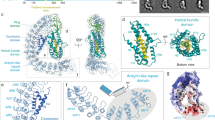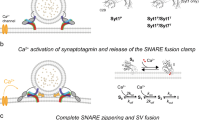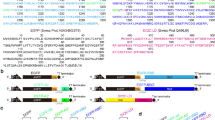Abstract
Several polypeptide neurotoxins affect presynaptic functions by interfering with chemical neurotransmission. This group of toxins includes botulinum toxin1, tetanus toxin2, β-bungarotoxin3 and black widow spider toxin (BWSTx)4–6. While the effect of the first three toxins is mainly a rapid and severe block of neurotransmitter release, BWSTx affects transmission by a massive stimulation of mediator release4–6. Despite various hypotheses put forward to explain the action of BWSTx at the level of nerve terminals, there is still a considerable degree of uncertainty as to the cation dependence of venom action7–11. Study of the toxin mode of action at the biochemical level has been hampered by the complexity and cellular heterogeneity of the preparations used, neuromuscular junction10 or synaptosomes6. PC12 cell line, derived from a rat phaeochromocytoma12, seems to be an excellent model in view of its property of synthesising and storing noradrenaline, dopamine and acetylcholine, and releasing them in depolarising conditions13. We have recently shown that highly purified BWSTx stimulates secretion from PC12 cells of previously taken up radioactive dopamine (DA) and noradrenaline (NA) (ref. 14 and manuscript in preparation). We report here that the earliest detectable event after toxin treatment of such cells is a massive increase of cytosolic calcium.
This is a preview of subscription content, access via your institution
Access options
Subscribe to this journal
Receive 51 print issues and online access
$199.00 per year
only $3.90 per issue
Buy this article
- Purchase on Springer Link
- Instant access to full article PDF
Prices may be subject to local taxes which are calculated during checkout
Similar content being viewed by others
References
Cull-Candy, S. G., Lundh, H. & Thesleff, S. J. Physiol., Lond. 268, 177–203 (1976).
Price, D. L., Griffin, J. W. & Peck, K. Brain Res. 12, 379–384 (1977).
Abe, T., Limbrick, A. & Miledi, R. Proc. R. Soc. B194, 545–553 (1976).
Frontali, N. et al. J. Cell Biol. 68, 462–479 (1976).
Grasso, A. Biochim. biophys. Acta 439, 406–412 (1976).
Grasso, A. & Senni, M. I. Eur. J. Biochem. (in the press).
Smith, J., Clark, A. N. & Kuster, T. A. J. Neurocytol. 6, 519–539 (1977).
Pumplin, D. W. & Reese, T. S. J. Physiol., Lond. 273, 443–457 (1977).
Tzeng, M. C., Cohen, R. S. & Siekevitz, P. Proc. natn. Acad. Sci. U.S.A. 75, 4016–4020 (1978).
Gorio, A., Rubin, L. L. & Mauro, A. J. Neurocytol. 7, 193–205 (1978).
Misler, S. & Hurlbut, W. P. Proc. natn. Acad. Sci. U.S.A. 76, 991–995 (1979).
Greene, L. A. & Tischler, A. S. Proc. natn. Acad. Sci. U.S.A. 73, 2424–2428 (1976).
Greene, L. A. & Rein, G. Brain Res. 129, 247–263 (1977).
Grasso, A., Alemà, S., Rufini, S. & Senni, M. I. VI Int. Symposium on Toxinology, Toxicon 17, Suppl. no. 1, abstract 54 (1979).
Stallcup, W. B. J. Physiol., Lond. 286, 525–540 (1979).
Finkelstein, A., Rubin, L. L. & Tzeng, M. C. Science 193, 1009–1011 (1976).
Chalfie, M., Hoadley, D., Pastan, S. & Perlman, R. L. J. Neurochem. 27, 1405–1409 (1976).
Ritchie, A. K. J. Physiol., Lond. 286, 541–560 (1979).
Miledi, R. Proc. R. Soc. B183, 421–425 (1973).
Baker, P. F. & Knight, D. E. Nature 276, 620–622 (1978).
Grasso, A., Rufini, S. & Senni, M. I. FEBS Lett. 85, 241–244 (1978).
Rubin, L. L., Gorio, A. & Mauro, A. Brain Res. 143, 107–124 (1978).
Author information
Authors and Affiliations
Rights and permissions
About this article
Cite this article
Grasso, A., Alemà, S., Rufini, S. et al. Black widow spider toxin-induced calcium fluxes and transmitter release in a neurosecretory cell line. Nature 283, 774–776 (1980). https://doi.org/10.1038/283774a0
Received:
Accepted:
Issue Date:
DOI: https://doi.org/10.1038/283774a0
This article is cited by
-
Somatodendritic integration under increased network activity in layer 5 pyramidal cells of the somatosensory cortex
Pflügers Archiv - European Journal of Physiology (2008)
-
α-LTX and α-LTXN4C induce [Ca2+]i elevation through different mechanisms in pancreatic β cells
Chinese Science Bulletin (2006)
-
Permeation of divalent cations through α-latrotoxin channels in lipid bilayers: steady-state current-voltage relationships
The Journal of Membrane Biology (1987)
-
Distinct sites of action of clostridial neurotoxins revealed by double-poisoning of mouse motor nerve terminals
Pflügers Archiv - European Journal of Physiology (1987)
-
Differentiation of PC12 phaeochromocytoma cells induced by v-src oncogene
Nature (1985)
Comments
By submitting a comment you agree to abide by our Terms and Community Guidelines. If you find something abusive or that does not comply with our terms or guidelines please flag it as inappropriate.



